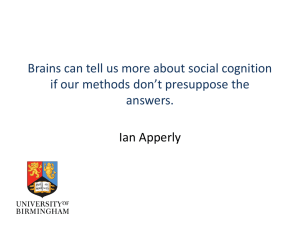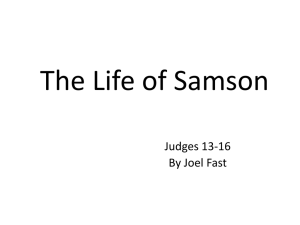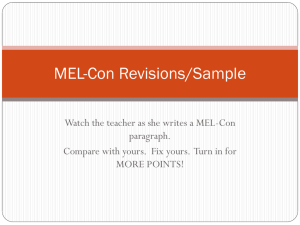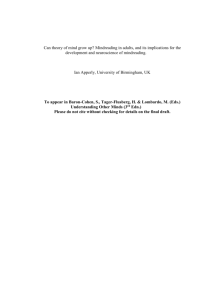Ian Apperly
advertisement
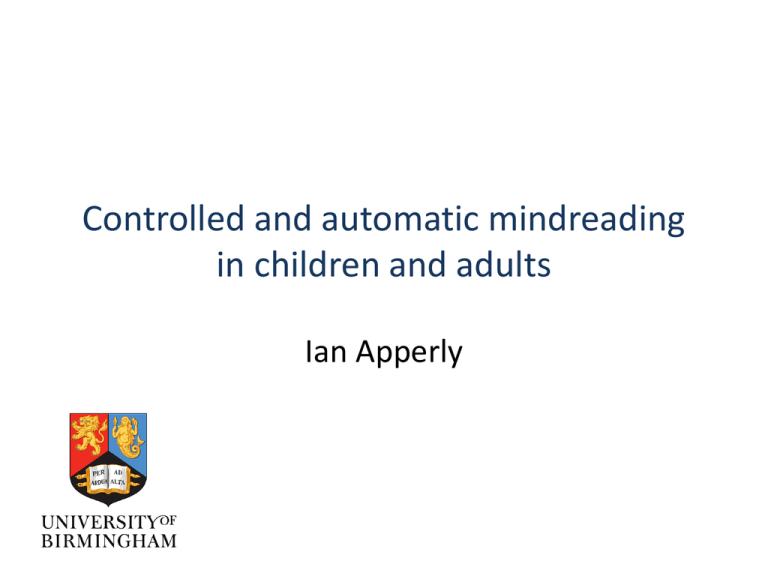
Controlled and automatic mindreading in children and adults Ian Apperly What is “Theory of Mind”? • • “Folk psychology”, “Perspective-taking”, “Social cognition” Essential for everyday social interaction and communication • • False belief tasks as a paradigm case (e.g., Wimmer & Perner, 1983) – These tasks ensure that participant must judge from other person’s point of view What is “Theory of Mind”? • • “Folk psychology”, “Perspective-taking”, “Social cognition” Essential for everyday social interaction and communication • • False belief tasks as a paradigm case (e.g., Wimmer & Perner, 1983) – These tasks ensure that participant must judge from other person’s point of view • Significant developments from infancy to early childhood • Disproportionately impaired in autism and several other genetic and psychiatric disorders What is “Theory of Mind”? • • “Folk psychology”, “Perspective-taking”, “Social cognition” Essential for everyday social interaction and communication • • False belief tasks as a paradigm case (e.g., Wimmer & Perner, 1983) – These tasks ensure that participant must judge from other person’s point of view • Significant developments from infancy to early childhood • Disproportionately impaired in autism and several other genetic and psychiatric disorders • Identifiable neural network Temporo-parietal junction / pSTS Temporal pole Medial prefrontal cortex TPJ TP Lateral view Medial view What is “Theory of Mind”? • Adults? Temporo-parietal junction / pSTS Temporal pole Medial prefrontal cortex TPJ TP Lateral view Medial view Overview • Part 1 – Evidence (from adults) that mindreading • Often requires cognitive control • May recruit specialised neural systems • May sometimes operate efficiently and automatically • Part 2 – How do these characteristics arise? • • Evidence that mindreading is a flexible but demanding ability In Adults.... Impaired executive processes can lead to severe egocentrism – • Belief reasoning requires cognitive control – • (Apperly, Back et al., 2008) Recursion (e.g., beliefs about beliefs) remains challenging – • • (e.g., Keysar, Lin & Barr, 2003; Apperly et al., 2010) Holding false beliefs briefly in mind has a measurable processing cost – • (Apperly, Samson, Riggs, Simpson & Chiavarino, 2006; Back & Apperly, 2010) Belief inferences are not used automatically – • (e.g., Bull, Philips & Conway, 2007) Belief inferences are not made automatically – • (e.g., Samson, Apperly, Kathirgamanathan & Humphreys, 2005) E.g., Mckinnon & Moscovitch (2007) And this converges with evidence from children… . A deductive Belief-Desire task (Hartwright, Apperly & Hansen, 2012) A deductive Belief-Desire task (Hartwright, Apperly & Hansen, 2012) NB only Belief factor involves a perspective difference A deductive Belief-Desire task (Hartwright, Apperly & Hansen, 2012) • B- is harder than B+ • D- is harder than D+ • (Replicates Apperly et al. 2011, Ch. Dev. Who found same pattern for adults and older children) Orthogonal contrasts of varying beliefs and desires (Hartwright, Apperly & Hansen, 2012) Overlap Belief (True vs. False) Desire (Like vs. Hate) IFG recruit EF, and attention/ToM areas Orthogonal contrasts of varying beliefs and desires (Hartwright, Apperly & Hansen, 2012) Overlap Belief (True vs. False) TPJ, ACC, Desire (Like vs. Hate) TPJ, ACC Orthogonal contrasts of varying beliefs and desires (Hartwright, Apperly & Hansen, 2012) Overlap Belief (True vs. False) TPJ, ACC, IFG Desire (Like vs. Hate) TPJ, ACC Notably no mPFC Evidence that mindreading is a flexible but demanding ability • • In Adults.... Impaired executive processes can lead to severe egocentrism – • Belief reasoning requires cognitive control – • (e.g., Keysar, Lin & Barr, 2003; Apperly et al., 2010) Holding false beliefs briefly in mind has a measurable processing cost – • (Apperly, Samson, Riggs, Simpson & Chiavarino, 2006; Back & Apperly, 2010) Belief inferences are not used automatically – • (e.g., Bull, Philips & Conway, 2007) Belief inferences are not made automatically – • (e.g., Samson, Apperly, Kathirgamanathan & Humphreys, 2005) (Apperly, Back et al., 2008) Recursion (e.g., beliefs about beliefs) remains challenging – E.g., Mckinnon & Moscovitch (2007) • And this converges with evidence from children… • • Mindreading seems to depend on processes for attention, working memory and executive control Recruitment reflects functional components of mindreading • . Specialised neural systems for Mindreading? (Saxe & Kanwisher, 2003......) False belief (FB) sample story John told Emily that he had a Porsche. Actually, his car is a Ford. Emily doesn’t know anything about cars though, so she believed John. — When Emily sees John’s car she thinks it is a porsche ford False photograph (FP) sample story A photograph was taken of an apple hanging on a tree branch. The film took half an hour to develop. In the meantime, a strong wind blew the apple to the ground. — The developed photograph shows the apple on the ground branch Specialised neural systems for Mindreading? (Saxe & Kanwisher, 2003......) False belief (FB) sample story John told Emily that he had a Porsche. Actually, his car is a Ford. Emily doesn’t know anything about cars though, so she believed John. — When Emily sees John’s car she thinks it is a porsche ford False photograph (FP) sample story A photograph was taken of an apple hanging on a tree branch. The film took half an hour to develop. In the meantime, a strong wind blew the apple to the ground. — The developed photograph shows the apple on the ground branch R-TPJ shows greatest specificity for reasoning about mental states. Contrast with mPFC, which also shows activity for thinking about body states, internal sensations and personal characteristics. Evidence that mindreading is a flexible but demanding ability • • In Adults.... Impaired executive processes can lead to severe egocentrism – • Belief reasoning requires cognitive control – • (e.g., Keysar, Lin & Barr, 2003; Apperly et al., 2010) Holding false beliefs briefly in mind has a measurable processing cost – • (Apperly, Samson, Riggs, Simpson & Chiavarino, 2006; Back & Apperly, 2010) Belief inferences are not used automatically – • (e.g., Bull, Philips & Conway, 2007) Belief inferences are not made automatically – • (e.g., Samson, Apperly, Kathirgamanathan & Humphreys, 2005) (Apperly, Back et al., 2008) Recursion (e.g., beliefs about beliefs) remains challenging – E.g., Mckinnon & Moscovitch (2007) • And this converges with evidence from children… • • • Mindreading seems to depend on processes for attention, working memory and executive control Recruitment reflects functional components of mindreading Quite strong evidence for some neural specialisation • . Evidence that mindreading is an efficient but inflexible processes? • • Can all mindreading really be so demanding? Two systems for mindreading? (e.g., Apperly & Butterfill, 2009, Psych. Rev.) Evidence that mindreading is an efficient but inflexible processes? • • Can all mindreading really be so demanding? Two systems for mindreading? (e.g., Apperly & Butterfill, 2009, Psych. Rev.) • Evidence of involuntary inference of: • • • • Sometimes without explicit awareness • • Simple visual perspective (Samson et al., 2010) Agent’s spatial frame of reference (Zwickell, 2011) Agent’s “false belief” (Kovacs et al., 2010) Schneider et al. (2011) Without need for “executive control” • Qureshi et al. (2010) • This pattern converges with evidence of mindreading in infants…. Automatic perspective-taking? (Samson, Apperly, Braithwaite et al., 2010, JEP:HPP) Only ever judge “self” – how many dots you can see Automatic perspective-taking? (Samson, Apperly, Braithwaite et al., 2010, JEP:HPP) 800 Reaction time (ms) 750 700 650 Consistent * ns 600 550 500 Self - avatar distractor Self - rectangle distractor Experiment 3 Only ever judge “self” – how many dots you can see Inconsistent Automatic perspective-taking? (Samson, Apperly, Braithwaite et al., 2010, JEP:HPP) 800 Reaction time (ms) 750 700 650 Consistent * ns 600 550 500 Self - avatar distractor Self - rectangle distractor Experiment 3 Only ever judge “self” – how many dots you can see Such effects are exaggerated under cognitive load (Qureshi et al., 2010) Inconsistent Overview • Part 1 – Evidence that mindreading • Often requires cognitive control • May sometimes operate efficiently and automatically • May recruit specialised neural systems • Part 2 – How do these characteristics arise? – We must look at developmental change Effortful & Flexible Efficient & limited Temporo-parietal junction / pSTS Temporal pole Medial prefrontal cortex TPJ TP Lateral view Medial view Effortful & Flexible ? Efficient & limited Temporo-parietal junction / pSTS Temporal pole Medial prefrontal cortex TPJ TP Lateral view Medial view How do we end up with automatic processes? (+ Language, Executive function, Knowledge) Effortful & Flexible Efficient & limited Automatisation a. Infant system grows up How do we end up with automatic processes? (+ Language, Executive function, Knowledge) Effortful & Flexible Efficient & limited b. Infant system remains intact Efficient & limited (+ Language, Executive function, Knowledge) Effortful & Flexible Automatisation a. Infant system grows up How do we end up with automatic processes? (+ Language, Executive function, Knowledge) Effortful & Flexible Efficient & limited b. Infant system remains intact Efficient & limited (+ Language, Executive function, Knowledge) Effortful & Flexible Both exist in development Automatisation a. Infant system grows up What is the origin of automatic perspective-taking? 900 Altercentric interference = indication of automatic perspective calculation 850 800 RT (ms) 750 700 Consistent Inconsistent 650 600 550 500 450 400 Self Other Self Other Main effect of consistency Discs vary Figure varies Significant interaction Self Other Blocked Evidence for automatisation? Surtees & Apperly (2012) Child Development 120 children aged 6-10 and adults Automatisation: Predict younger children to suffer less interference for self judgements. Original automaticity: Predict equivalent interference at all ages. “You see 2” Or “He sees 2” Evidence for automatisation? Surtees & Apperly (2012) Child Development 120 children aged 6-10 and adults “You see 2” Or “He sees 2” OTHER SELF Consistency Response Time (ms) Consistent 2000 Inconsistent 1500 1000 500 0 Age 6 Experiment 8 10 1A Adult* 8 1B 6 8 10 1A Adult* 8 1B Consistency 0.20 Consistent Inconsistent Automatic perspective-taking? – In adults, Level-1 visual perspectives may be calculated even when unnecessary and unhelpful – Automatic? – What is the developmental origin of automaticity? – Original automaticity? – Automatisation? No evidence of automatization Neural specialisation through development • E.g., Reading development • correlation with children’s reading skill – Yellow = +ve – Blue = -ve • Neural specialisation emerges • Unlikely to be determined by an evolved programme Turkeltaub et al. 2003 Developmental specialisation of a rTPJ (Gweon et al. 2012, Ch. Dev.) • 5-11Y children, and adults • 3 story conditions in fMRI – Physical – Social – Mental (+Social) • Battery of mindreading tasks outside of scanner Developmental specialisation of a rTPJ (Gweon et al. 2012, Ch. Dev.) Developmental specialisation of a rTPJ (Gweon et al. 2012, Ch. Dev.) Developmental specialisation of a rTPJ (Gweon et al. 2012, Ch. Dev.) Differentiation of social and mental in rTPJ was correlated with mindreading success outside of the scanner Summary • Part 1 – Evidence that mindreading • Often requires cognitive control • May sometimes operate efficiently and automatically • May recruit specialised neural systems • Part 2 Temporo-parietal junction / pSTS Temporal pole Medial prefrontal cortex TPJ TP Lateral view – Development must be explained – Development constrains theories of the mature system Medial view Social abduction (Hartwright, Apperly & Hansen, in prep) Social abduction (Hartwright, Apperly & Hansen, subm.) TB vs. FB Green = D? vs. D-&D+ Green = D? vs. D-&D+&FB&TB Selective for D?
